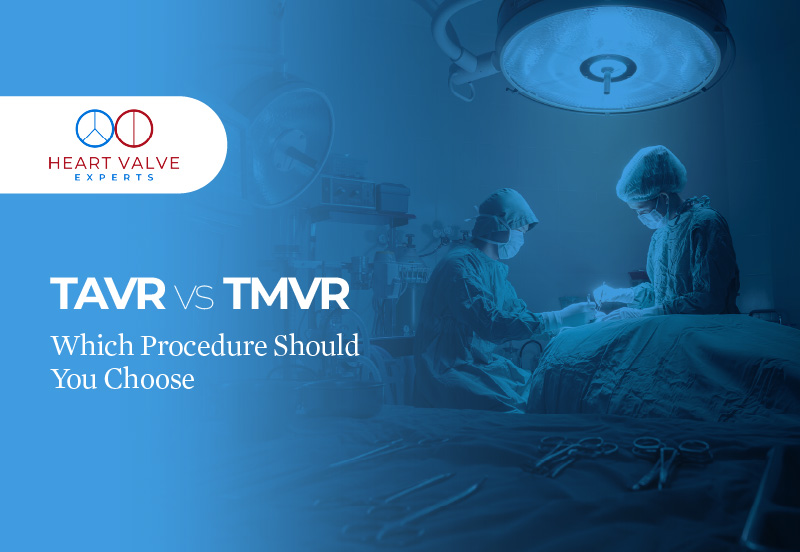Our hearts—those steadfast engines of life—can show signs of wear as we age. Perhaps you’ve been diagnosed with a leaky mitral valve or a narrowed aortic valve, and the phrase what is TAVR surgery has come up in conversation with your cardiologist. You’re over 65, managing other health conditions like diabetes or high blood pressure, and the thought of traditional open-heart surgery can be frightening: large chest incisions, days in the intensive care unit, significant pain, and weeks or months of recovery.
Thankfully, advances in catheter-based therapy—specifically the TAVR procedure (transcatheter aortic valve replacement) and the TMVR procedure (transcatheter mitral valve replacement)—offer safer, gentler alternatives that can help you return to daily life faster. In this in-depth guide, we’ll explain both approaches, weigh their risks and benefits, and help you decide which transcatheter solution best fits your heart and lifestyle.
Why Valve Replacement Matters?
Your heart relies on four one-way valves to direct blood flow. Over time, these valves may malfunction:
Aortic stenosis:
Occurs when the aortic valve narrows and stiffens. The left ventricle must pump harder to push blood into the body, leading to fatigue, chest pain, dizziness, and eventually heart failure if left untreated.
Mitral regurgitation
Happens when the mitral valve leaks, allowing blood to flow backwards into the left atrium. This can cause breathlessness, swelling, and irregular heart rhythms.
Mitral stenosis
A less common but serious problem—means the mitral valve doesn’t open fully, restricting blood flow and causing similar symptoms.
Valve replacement restores normal circulation, relieves symptoms, and improves quality of life. Traditionally, surgical valve replacement required opening the chest (sternotomy), stopping the heart, and using a heart-lung bypass machine. But for many seniors and high-risk patients, that invasiveness comes with heightened risks. Minimally invasive catheter-based techniques like TAVR and TMVR now allow valve replacement through tiny puncture sites, reducing trauma and speeding recovery.
What Is TAVR Surgery?
Transcatheter Aortic Valve Replacement—commonly called TAVR—is a minimally invasive procedure that replaces a diseased aortic valve without cracking open the chest. When patients ask, “What is TAVR surgery?” the answer lies in its elegant approach: a thin tube (catheter) is inserted through a small incision in the groin (femoral artery) or sometimes the chest, then guided to the heart under X-ray and ultrasound. Once positioned, the new valve, mounted on a collapsible frame, is expanded inside the old, calcified valve. The result is an instant restoration of proper valve function without removing the original valve tissue.
Key Benefits of Transcatheter Aortic Valve Replacement
- Less Invasive: No sternotomy, no cardiopulmonary bypass, often performed under local anaesthesia or light sedation.
- Shorter Procedure Time: Typically 1–2 hours in the catheterisation lab.
- Rapid Recovery: Patients usually sit up and walk within 24 hours and can be discharged in 2–3 days.
- Reduced Pain & Scarring: A tiny puncture wound versus a long chest incision.
- Lower Immediate Risk: Fewer complications such as significant bleeding, infection, or lung issues.
Clinical trials have shown that for patients aged 75 and older, or anyone at intermediate to high surgical risk, the TAVR procedure delivers outcomes comparable or superior to open-heart surgery, with fewer early complications and faster improvements in quality of life.
What Is the TMVR Procedure?
While TAVR addresses the aortic valve, Transcatheter Mitral Valve Replacement (TMVR)—also known as TMVR—treats mitral valve diseases using a similar catheter-based technique. The mitral valve’s complex shape and orientation make TMVR more technically challenging, but specialised devices and imaging guidance have made it a reality for many high-risk patients.
How Transcatheter Mitral Valve Replacement Works?
- Access Site: The entry point is a small incision in the groin vein (femoral vein).
- Trans-Septal Puncture: Under transesophageal echo and fluoroscopy guidance, the interatrial septum is punctured to reach the left atrium.
- Valve Delivery: A catheter carries the replacement mitral valve to the diseased native valve.
- Deployment & Anchoring: The new valve is expanded and locked into place, sealing tightly to prevent regurgitation.
Advantages of the TMVR Procedure
- Minimally Invasive: It avoids splitting the breastbone and halting the heart.
- Faster Recovery: Many patients return home in 3–5 days and resume light activities within 2–4 weeks.
- Ideal for High-Risk Patients: Those with frailty, comorbidities, or previous cardiac surgeries who face prohibitive risks with open surgery.
Although TMVR is newer than TAVR and long-term durability data are still accumulating, early results show marked symptom relief, improved heart function, and a low rate of procedural complications.
Comparing TAVR Procedure vs. TMVR Procedure
When assessing transcatheter aortic valve replacement against transcatheter mitral valve replacement, it’s vital to remember these procedures target different valves and disease processes. Your decision hinges not on “Which is better?” but on “Which is appropriate for my specific valve issue?” Consider:
1. Valve Affected
- TAVR: Replaces the aortic valve (treats aortic stenosis).
- TMVR: Replaces the mitral valve (treats mitral regurgitation or stenosis).
2. Procedure Complexity
- TAVR: More established, with over a decade of global experience and robust long-term data.
- TMVR: Evolving rapidly, with specialised centres gaining expertise in complex mitral anatomy.
3. Anaesthesia Requirements
- TAVR: Often local anaesthesia plus conscious sedation.
- TMVR: Usually requires general anaesthesia or deep sedation due to the trans-septal puncture.
4. Recovery Timeline
- TAVR: Most patients resume daily activities within 1–2 weeks.
- TMVR: Activity returns in 2–4 weeks, with follow-up imaging to confirm valve position and function.
5. Durability & Follow-Up
- TAVR valves: Proven performance up to 10+ years in many patients.
- TMVR valves: Early data are promising; ongoing studies will clarify long-term outcomes.
Why Seniors and High-risk Patients Favour Catheter-Based Therapies?
Traditional open-heart valve surgery, while highly effective, entails risks that increase with age and comorbidity:
- Frailty and reduced muscle mass slow surgical recovery.
- Chronic lung, kidney, or liver disease heightens anaesthesia and bypass risks.
- Prior heart surgeries or scar tissue complicates sternotomy.
- Diabetes or vascular disease increases infection and bleeding concerns.
By contrast, catheter-based procedures like the TAVR procedure and TMVR procedure significantly reduce trauma to the chest wall and avoid complete cardiopulmonary bypass. This translates into:
- Lower Early Complication Rates (bleeding, infection, Pneumonia).
- Shorter ICU and Hospital Stays.
- Faster Return to Independence, preserving quality of life.
For many seniors, this gentler path makes all the difference between a daunting ordeal and a manageable, empowering step toward better health.
Risks & Safety Considerations
No medical intervention is risk-free. Both TAVR and TMVR carry potential complications:
- Bleeding or Vascular Injury at the access site (usually minor and manageable).
- Stroke risk of 2–4% due to embolic debris; best mitigated by cerebral protection devices.
- Arrhythmias or heart block, sometimes requiring pacemaker implantation (more common in TAVR).
- Valve malposition or leak is minimised by advanced imaging and device designs.
- Infection & Pneumonia are lower than open surgery, but are still monitored closely.
In clinical trials comparing TAVR to surgical aortic valve replacement in intermediate-risk and high-risk patients, TAVR demonstrated similar or improved survival at 1 year, with fewer major bleeding events and faster quality-of-life gains. Early TMVR series show similarly encouraging safety profiles in carefully selected patients.
How to Decide: The Personalised Heart-Team Approach
Choosing between transcatheter therapies and surgery, or between TAVR and TMVR, requires a multidisciplinary heart-team assessment:
- Comprehensive Imaging: Echocardiography, CT angiography, and 3D reconstructions to define valve anatomy.
- Risk Stratification: Scoring systems (STS, EuroSCORE) to quantify surgical risk.
- Shared Decision-Making: Review your medical history, lifestyle goals, and personal preferences.
- Tailored Recommendation: Collaboration among interventional cardiologists, cardiac surgeons, imaging specialists, and anaesthesiologists.
Key questions to ask your team:
- “Am I an ideal candidate for the TAVR procedure based on my aortic valve anatomy?”
- “Does my mitral valve disease qualify me for a TMVR procedure, and what recovery should I expect?”
- “What’s the balance between short-term benefits and long-term durability in my case?”
Preparing for Your Transcatheter Procedure
Once you and your heart team decide on TAVR or TMVR, you’ll follow a streamlined preparation plan:
- Pre-Procedure Testing: Blood work, imaging, and anaesthesia evaluation.
- Medication Adjustment: Managing blood thinners and other cardiac drugs.
- Hospital Admission: Often, the day before, your team will review the plan and answer questions.
- Recovery Planning: Arrange for home support, a restful environment, and rehabilitation services.
Life After TAVR or TMVR: What to Expect?
Most patients emerge from a TAVR procedure or TMVR procedure with noticeably improved energy and reduced symptoms:
- Enhanced Stamina: Less shortness of breath during daily activities.
- Renewed Independence: Ability to walk, garden, and socialise without fatigue.
- Emotional Well-Being: Relief from chronic symptoms and anxiety about heart failure.
Follow-up visits and imaging ensure your new valve continues to function optimally. Many seniors enjoy a whole, active life for years after their transcatheter procedure, with ongoing surveillance akin to routine check-ups.
Ready to Take the Next Step?
Don’t let valve disease hold you back—our Heart Valve Experts are here.
- Schedule Your Personalised Consultation Today: Book a no-obligation appointment here.
- Have Questions? Call +91-9004506263 or email heartvalveexperts@gmail.com.
Also Read:

